Marine mammals are an exceptional group of animals. Characteristics of mammals include the bearing of live young and nursing of their young with milk produced by their mammary glands. Furthermore, mammals are warm-blooded, breath with their lungs, and typically have either fur or hair. Marine mammals have adapted to living in the water. While their bodies have adapted to a more streamline form, they typically have a thick layer of fat to help insulate against the cold water. These mammals have adapted to spend longer periods of time underwater by allowing oxygen to be stored in the blood and muscles.
Although all marine mammals are protected by international laws, among which is the Marine Mammal Protection act, many marine mammals are endangered. The IUCN, short for International Union for Conservation of Nature and Natural resources, has established a list, where species according to population numbers and their life history are ranked from least concern to extinct. The list, also called IUCN red list, has a total of 9 categories where species are categorized according to their conservation status. The list is divided into: Not Evaluated, Data Deficient, Least Concern, Near Threatened, Vulnerable, Endangered, Critically Endangered, Extinct in the Wild and Extinct. Apart from this valuable information that is used to implement conservation efforts and policies, the IUCN red list also provides information about the species population size, dispersal range, ecology, habitat, threats and conservation actions. In the following, you can find our list of the 8 most interesting marine mammals facts.
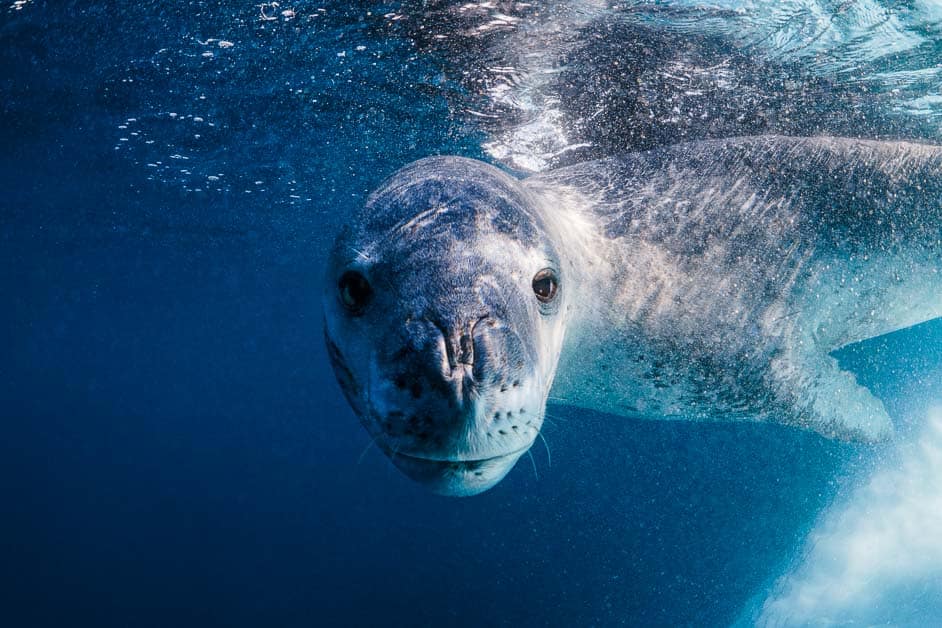
INTERESTING MARINE MAMMALS ON THE PLANET
INTERESTING MARINE MAMMALS
Top 8 Mammals
Narwhal
CONSERVATION STATUS
Least concern
EST. GLOBAL POPULATION
123,000
MAJOR THREATS
Human habitat destruction, ships, fishing, pollution, climate change
LENGTH
21.0 ft (5.1m)
MASS
2072 pounds (940 kg)
SPEED
4mph (6.5 km/h)
FEEDS ON
Fish, squid, shrimp
COMMONLY FOUND IN
Canada, Greenland, Russia, Svalbard, Jan Mayen
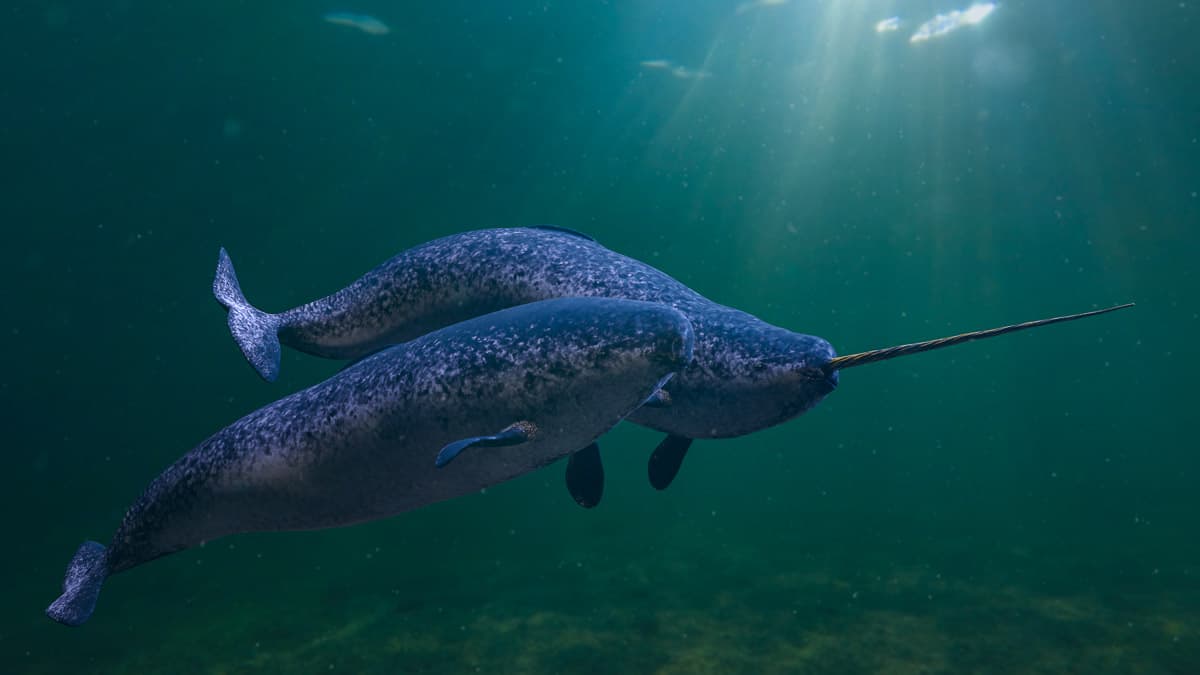
The Narwhal (scientific name: Monodon monoceros) is an exceptionally interesting marine mammal – some say that Narwhals are the Unicorns of the Sea. The unicorn name derives from the males having one long tooth that extends forward – like a sword. The spiral sword-like tusk can attain around 8.8 ft (2.7m) in length and is assumed to play a role in mating rituals. Although more prominent in males, some females may exhibit a small tusk(1).
While Narwhals are usually in groups of 15 to 20, sometimes they travel in pods of hundreds of individuals. Their diet mainly consists of fish, shrimp, squid, and crabs. Although listed as Least Concern on the IUCN red list, these ocean mammals are subject to human habitat destruction caused by residential and commercial development. Furthermore, oil and gas drilling is a major threat as well as excessive fishing and the harvesting of aquatic resources. The pollution caused by such industries poses a major risk for these ocean creatures and the sensitive environment they call home. Shipping lanes pose a risk for injury and allow for the introduction of invasive (non-native) species, diseases, and problematic genes, which add to the list of threats to the populations. Last but most importantly, climate change causes not only habitat-shifts and habitat-alterations but also severe weather conditions that pose an enormous threat to Narwhal populations(2).
Blue Whale
CONSERVATION STATUS
Endangered
EST. GLOBAL POPULATION
5,000 to 15,000
MAJOR THREATS
Ships, fishing, climate change
LENGTH
82.0 ft (25m)
MASS
110,231 to 330,693 pounds (50,000 to 150,000 kg)
SPEED
31 mph (50 km/h)
FEEDS ON
Krill and copepods
COMMONLY FOUND IN
North Atlantic, North Pacific, Eastern tropical & south pacific, southwestern pacific, Indian ocean, Antarctic, Southern Ocean
The Blue Whale (scientific name: Balaenoptera musculus) is another interesting marine mammal that stands out due its incredible size. With individuals reaching a length of up to 100ft (30m), and an average length of 82ft (25m) Blue Whales are the largest animals that are known to have lived on this planet. While their body weight can reach up to 200tons, a blue whale`s heart weighs about as much as a car and their tongue alone can be as heavy as an elephant(1).
These gentle giants can be found all over the world’s oceans and usually swim alone and sometimes in small groups. There is limited knowledge on their reproduction, however, their diet seems to consist nearly exclusively of krill, and occasionally of other copepods. The feeding process involves the filtration of huge amounts of water to get to these small animals. It is thus very-impressive to reach such a length and weight, while feeding on such tiny creatures(3).
Additionally, Blue Whales are amongst some animals that can get relatively old. While the oldest ever determined age of a Blue Whale, was estimated at 110, the average lifespan is between 80 and 90 years(3). While nowadays the Blue Whale is listed as Endangered on IUCN, the excessive hunt for whale oil in the 1900s nearly drove these impressive ocean animals to extinction. In 1966, after 360 000 Blue Whales were slaughtered in mid-1960, the Blue Whale was put under protection by the International Whaling Commission. Since then, the Blue Whale populations are slowly recovering. Due to their long generation times and old ages, the population can only recover very slowly(2).
Nowadays, blue whales face threats such as the unavailability of sufficient food through excessive fishing and harvesting of aquatic resources. Furthermore, many are killed or injured by big boats, and climate change, as well as severe weather conditions, pose a major threat to these majestic creatures(2).
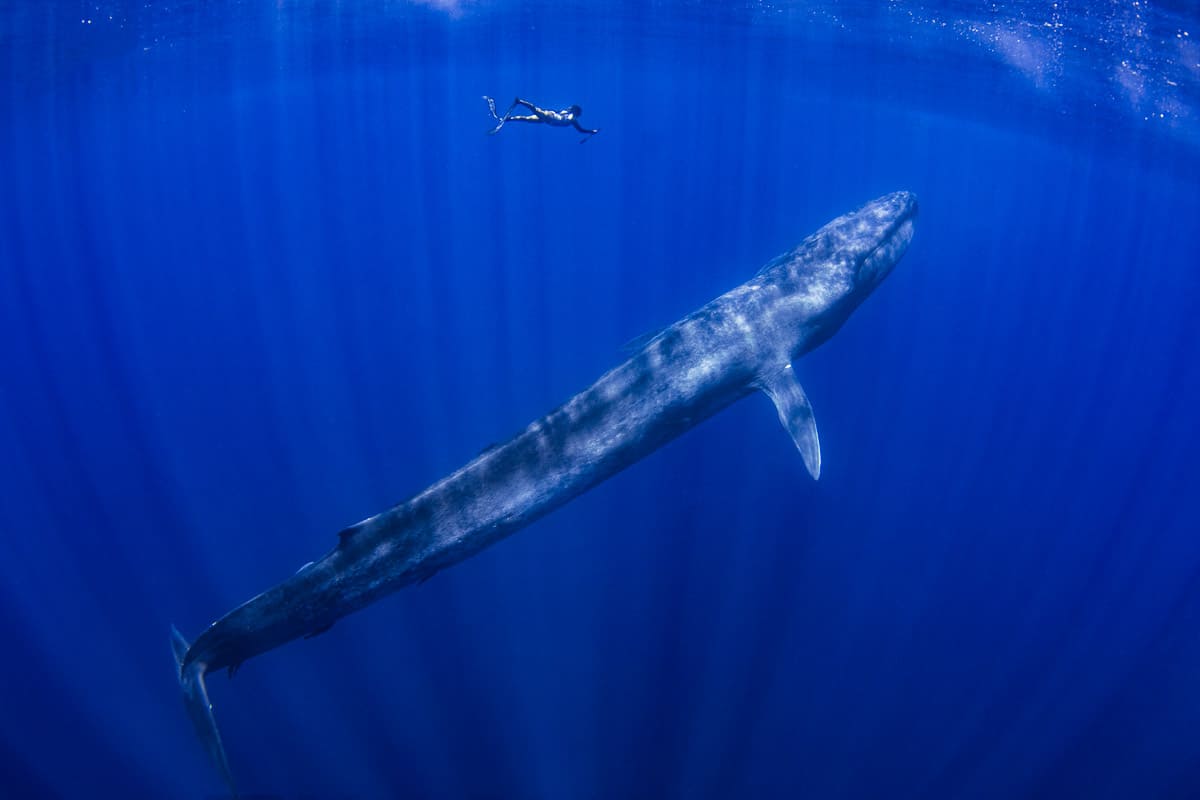
Vaquita
CONSERVATION STATUS
Critically Endangered
EST. GLOBAL POPULATION
10 – 18
MAJOR THREATS
Fishing, dams, pollution
LENGTH
3.9 to 4.9 ft (1.2 to 1.5m)
MASS
95 pounds (43 kg)
SPEED
2.5 mph (4km/h)
FEEDS ON
Fish, squid, crustaceans
COMMONLY FOUND IN
Baja California (Mexico)
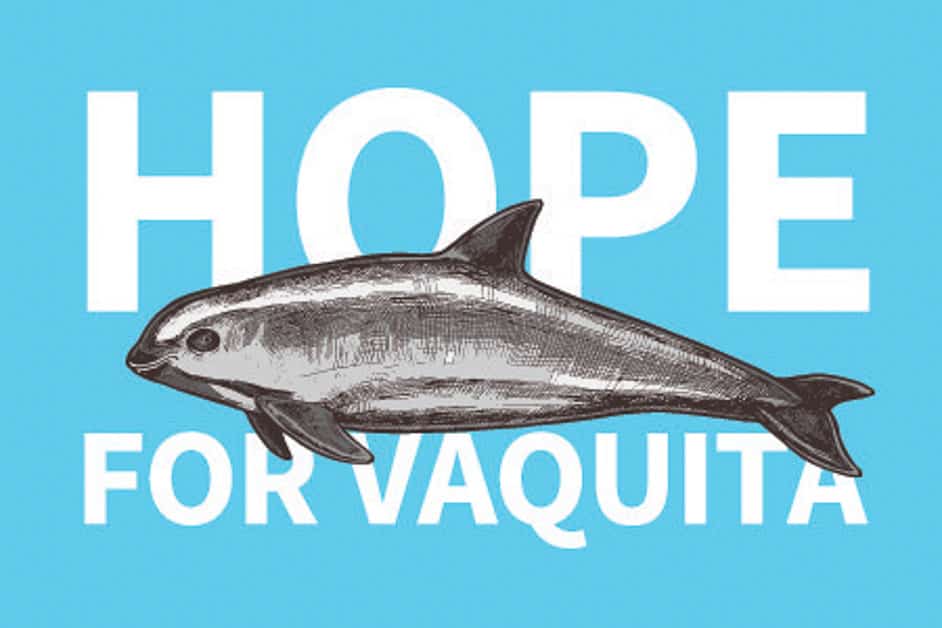
The Vaquita (scientific name: Phocoena sinus) is the most endangered marine animal in the world. With an estimated population size of a total of only 18 individuals, the species is near extinction(2). Vaquitas are the smallest of all cetaceans. Cetaceans are an infra-order, which includes whales, dolphins, and porpoises. Within the infra-order of Cetacean fall Toothed whales and Baleen whales. To this date known, there are a total of 70 Toothed whale species, which include dolphins, porpoises, beluga whale, Narwhal, Sperm hale and beaked whale. An estimated 15 species that belong to baleen whales, the filter feeders. These include, amongst others, the Blue Whale and Humpback Whale(4).
The Vaquita is on the edge of extinction. In 2017, their population number was at 18, while today there are estimated to be less than 10 individuals left in our oceans. While its habitat is limited to Mexico’s Gulf of California, the smallest of all cetaceans frequently end up dead in gill nets. Unfortunately to this day, there is still rampant illegal fishing in marine protected areas, taking place all over the world. Furthermore, habitat destruction through fishing, harvesting of marine resources as well as dams and water use has greatly limited their habitat. Additionally, the pollution of Urban and Domestic wastewater, industrial and military pollution, as well as effluents through agriculture and forestry, have placed additional pressure on the habitats of these animals. Through this, the population has no chance to recover and even though conservation efforts are in place, the stressors are too high, and their numbers are dropping, towards extinction(2).
Amazon River Dolphin
CONSERVATION STATUS
Endangered
EST. GLOBAL POPULATION
13,000
MAJOR THREATS
Humans, mining, fishing, dams, pollution
LENGTH
8.2 ft (2.5m)
MASS
408 pounds (185 kg)
SPEED
0.9 to 2 mph (1.5 to 3.2 km/h)
FEEDS ON
Fish, shrimp, crabs
COMMONLY FOUND IN
Bolivia, Brazil, Colombia, Ecuador, Peru, Venezuela
The Amazon River Dolphin (scientific name: Inia geoffrensis) belongs to one of the most interesting marine mammals. This Dolphin lives in the Amazon river, in freshwater, instead of in the salty waters of the ocean, like most other marine mammals. Apart from the difference in habitat, males of this ocean mammal also have a different color – they are pink. Their pink color is important for reproduction. The pinker the males, the more attractive they are to females. Scientists believe that their pink color comes from fights or rough games(1, 3).
During the rainy season, great parts of the Amazon forest flood, and females use this small sea under the amazon tree canopy to roam around and are believed to escape from the aggressive males when they have the chance. These dolphins are extremely agile and are therefore able to swim in, around, and underneath the root-systems of trees. Actually, through their unfused neck vertebrae, they can bend up to about a 90°-angle(4).
The main threats of the Amazon River Dolphin are all due to human influence. These cute dolphins are being hunted for catfish bait or end up dying in gill nets. The expansion of residential and commercial areas has put more pressure on the already dwindling populations. The increase of the human population in close proximity to their habitat has brought war, military exercises as well as the recent deforestation through massive fires. Besides, dams and water management, as well as water use, have limited their habitat. Furthermore, Oil and Gas drilling, as well as mining and quarrying, pose threats to this species. On top of all these threats comes the pollution through industrial and military exercises as well as effluents originating from agriculture and forestry(2).
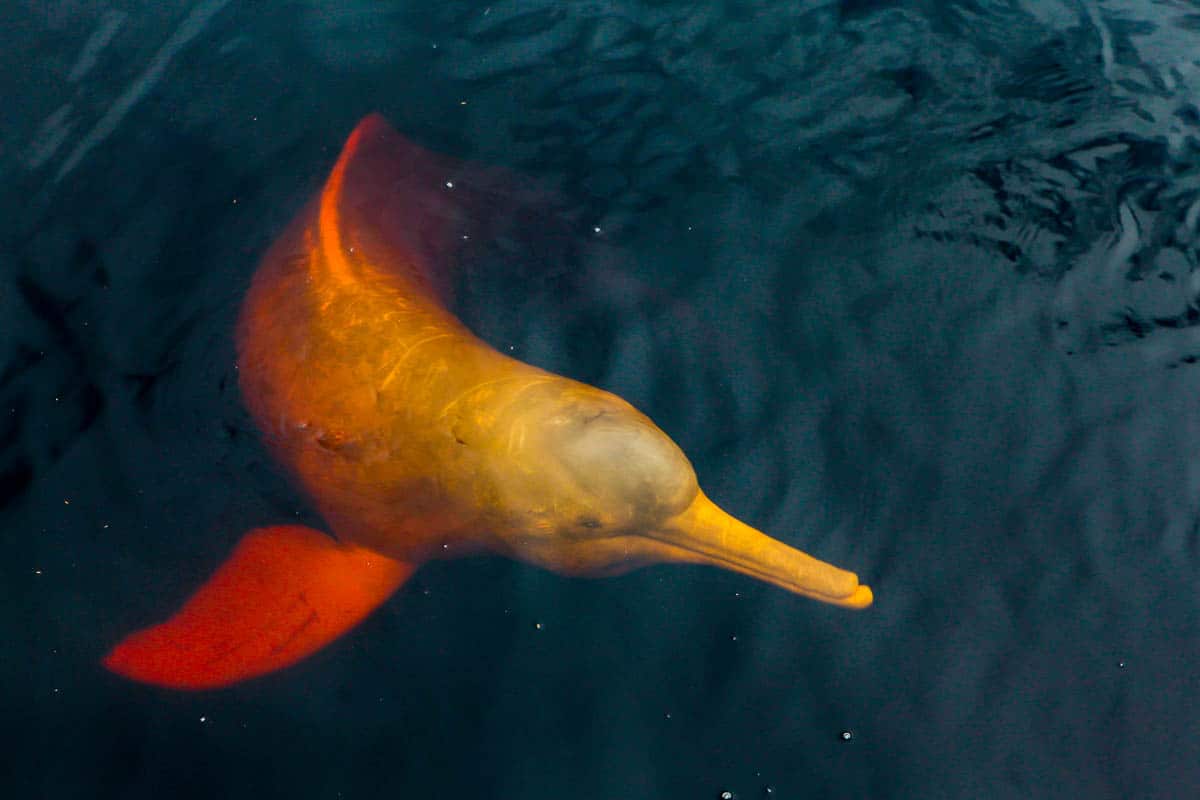
False Killer Whale
CONSERVATION STATUS
Not Applicable
EST. GLOBAL POPULATION
Unknown
MAJOR THREATS
Pollution
LENGTH
20 ft (6.1m)
MASS
2600 pounds (1179 kg)
SPEED
18 mph (29 km/h)
FEEDS ON
Fish, squid
COMMONLY FOUND IN
Croatia, Germany, Denmark, France, Greece, Gibraltar, Italy, Ireland, Malta, Netherlands, Norway, Spain, Portugal, United Kingdom
The false killer whale (scientific name: Pseudorca crassidens) got its name through its similar form and proportion compared to the Orca (Killer Whale). In contrast to the white and black coloring of the Orca, the false killer whale is colored completely black or dark grey. Some of these animals do have lighter areas that are located on the belly side (ventrally)(1).
The false killer whale is found throughout all tropical and subtropical oceans across the world. Through its broad distribution, it is difficult to estimate population size. Therefore, the IUCN is not able to place this species in a category on the red list. Nevertheless, since it can be found spread around the world in all tropical and subtropical environments, population sizes are assumed to be healthy. The main threats to this species have been identified and include diet depletion through commercial fishing, death in fisher nets as well as noise pollution(2).
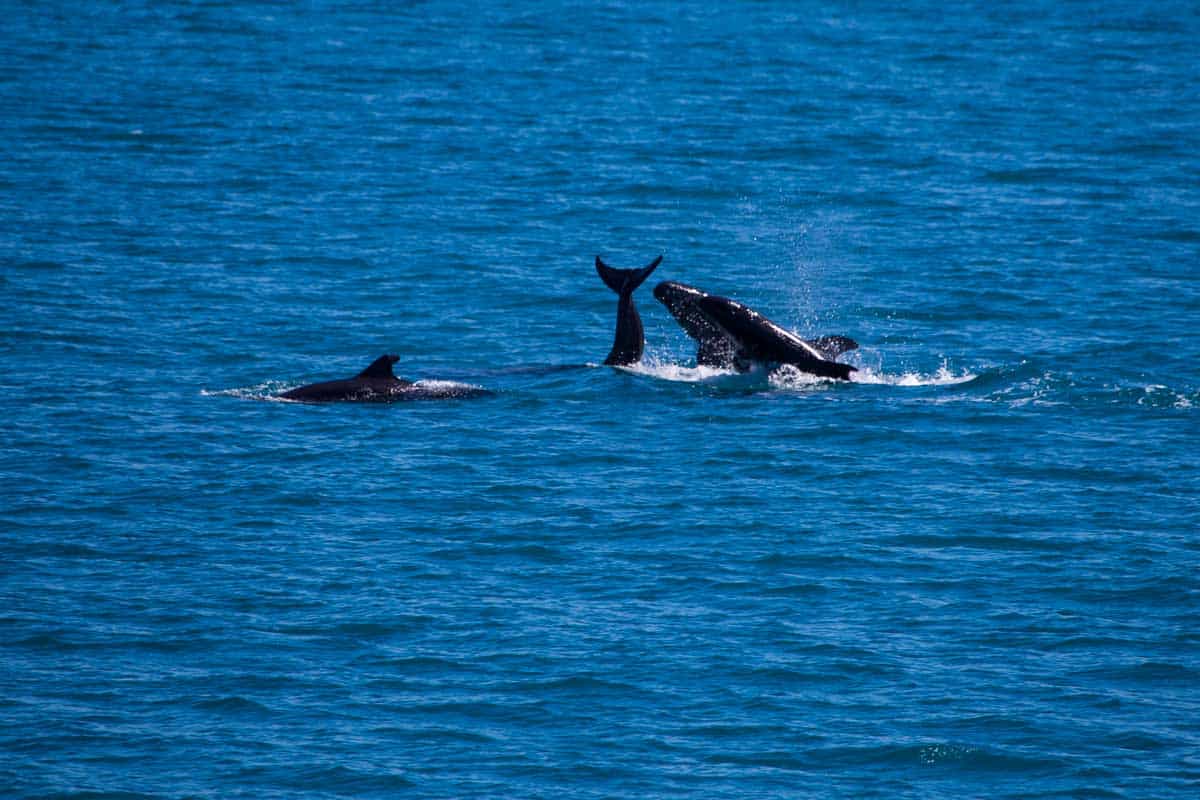
Humpback Whale
CONSERVATION STATUS
Least concern
EST. GLOBAL POPULATION
84,000
MAJOR THREATS
Mining, ships, fishing, pollution
LENGTH
49 ft (15m)
MASS
66,139 pounds (30,000 kg)
SPEED
3 to 9 mph (5 to 15 km/h)
FEEDS ON
Crustaceans, plankton, small fish
COMMONLY FOUND IN
Worldwide, open ocean
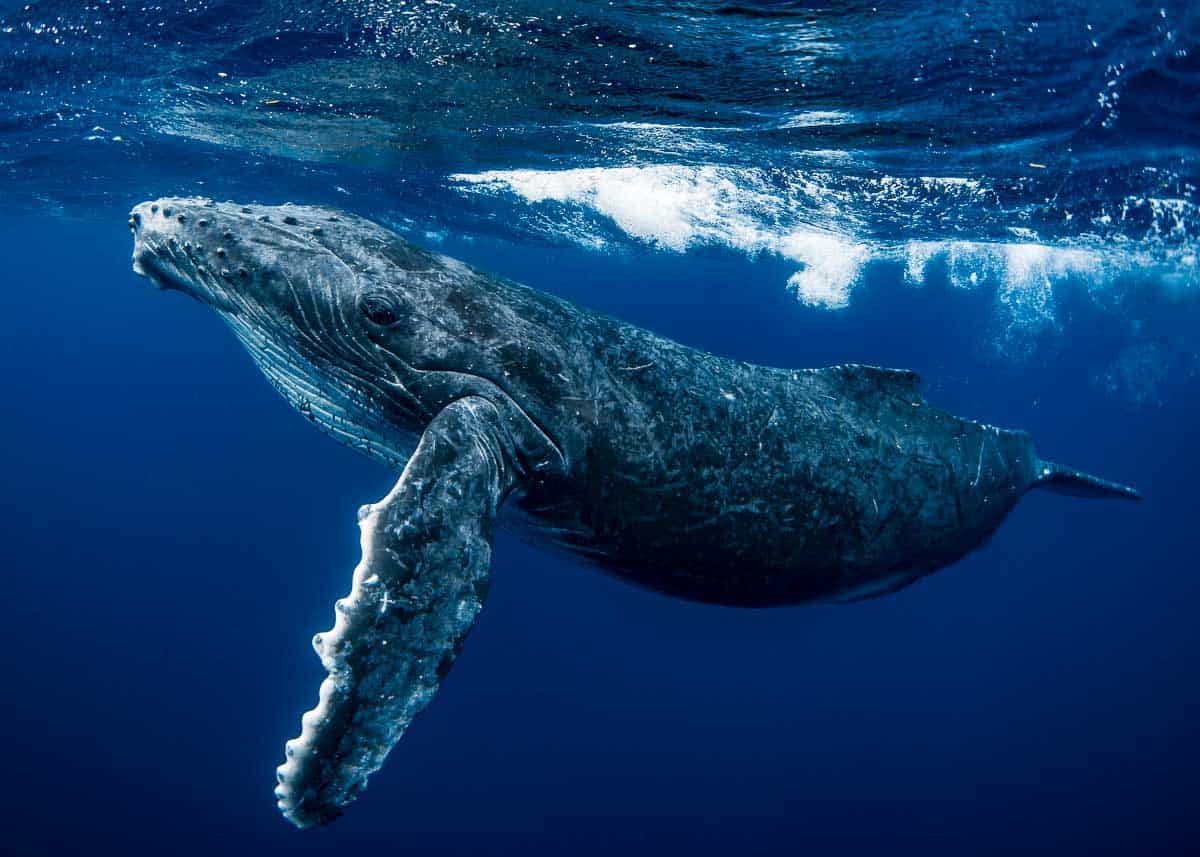
The Humpback whale (scientific name: Megaptera novaeangliae) has its name from the way the animals dive down into the ocean. While diving down, their back looks like a hump that is eventually followed by their tail. Translated, the scientific (Latin) name means “Big wing of New England”. This name was given by early European whalers who were some of the first to encounter these creatures, off New England and the name refers to their spectacularly large pectoral fins(1, 3).
Humpback whales are distributed across the world’s oceans and on the coasts, they are known for their incredible jumps. Their population size is estimated at 84000 individuals and IUCN lists this species as least concern on the IUCN red list of endangered species. Before the ban on commercial whaling in 1985, these ocean mammals were facing a strong decline. Ever since the ban, populations were able to recover and are still increasing. Nowadays, the main threats include drilling for oil and gas, collisions with commercial ships, depletion of prey through excessive fishing and getting trapped in fishing gear as well as pollution(2).
Dugong
CONSERVATION STATUS
Vulnerable
EST. GLOBAL POPULATION
Unknown
MAJOR THREATS
Humans, ships, fishing, pollution, climate change
LENGTH
8.5 ft (2.6m)
MASS
661 pounds (300 kg)
SPEED
6 mph (9.6 km/h)
FEEDS ON
Seagrass and marine algae
COMMONLY FOUND IN
Coastline of: northern Australia, Indonesia, South Asia, East Africa
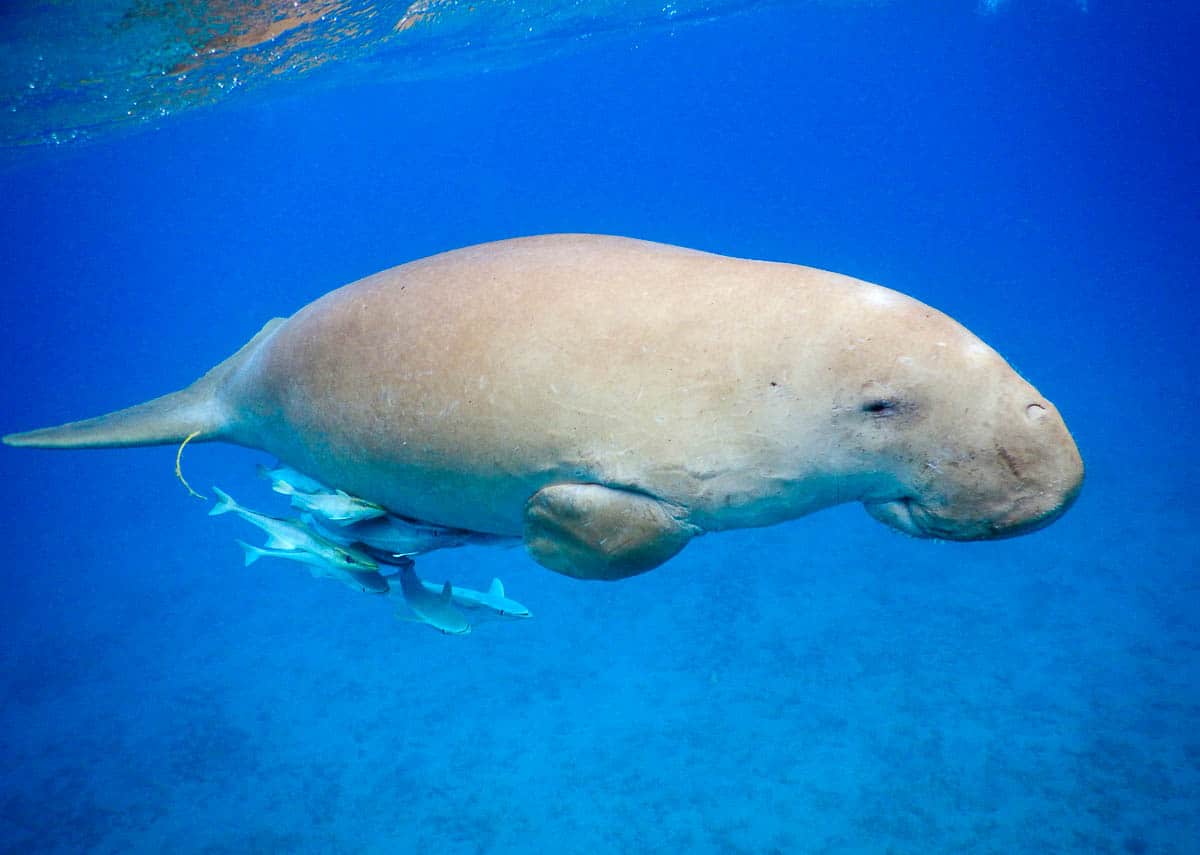
The Dugong (scientific name: Dugong dugon), as well as its close relatives the Manatees, are distantly related to the land-mammal, the Elephant. Although Dugongs and Manatees look very similar and exhibit similar behaviors, there are notable differences. One thing all of them have in common is that they are all vegetarians. While Dugongs and Manatees look very similar, the Dugong`s tail is formed similar to a whale`s tail(1).
These cute ocean animals are one of the most interesting marine mammals swimming in our oceans and are found across coastlines of Northern Australia, Indonesia, South Asia, and East Africa. While estimated population sizes are unknown due to a lack of research, the IUCN has listed these delicate water mammals as a vulnerable species. This partly because they are facing many threats. Threats include hunting, since Dugongs have always been an easy target for hunters because they live and forage in close proximity to the coast. Additionally, human disturbance, as well as pollution pose major threats to Dugongs. A big threat to the populations is the increasing events of flooding and storms influenced by climate change(2).
Leopard Seal
CONSERVATION STATUS
Least concern
EST. GLOBAL POPULATION
18,000
MAJOR THREATS
Fishing, humans, diseases, climate change
LENGTH
9.8 ft (3m)
MASS
772 pounds (350 kg)
SPEED
24 mph (38.6 km/h)
FEEDS ON
Fish, penguins
COMMONLY FOUND IN
Antarctica, French southern territory, South Sandwich Islands, South Georgia, Heard island, McDonald island
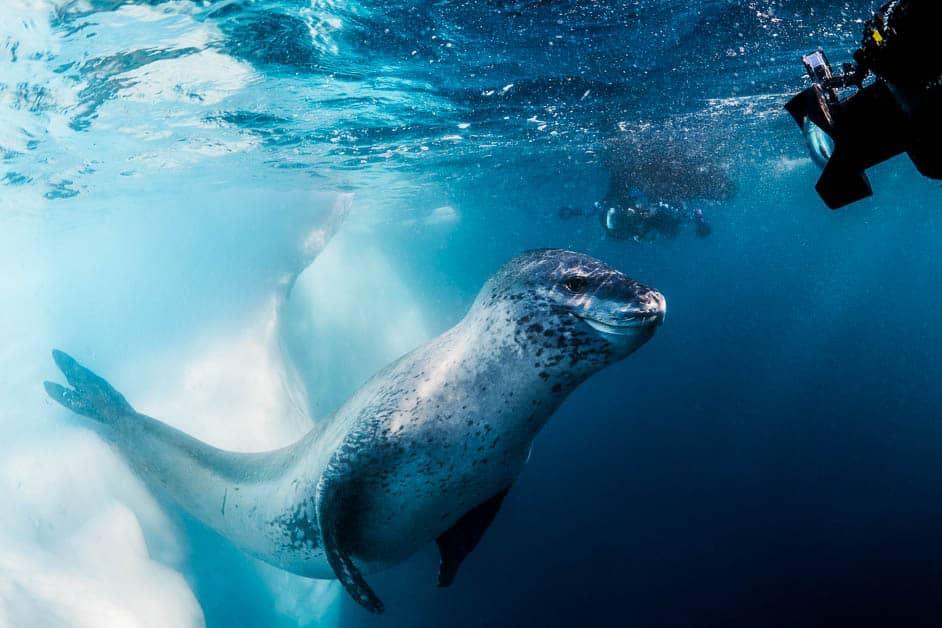
The leopard seal (scientific name: Hydrurga leptonyx) is an extremely fast predator and the only seal that feeds on other seals. Its main prey, however, is penguins and fish. The Leopard seal is fast enough to catch penguins underwater and through its speed, the seal can jump out of the water and land on ice or land, with minimal effort. These seals are equipped with strong jaws, lined with long teeth, preying on unsuspecting seals and penguins, with ease.
The leopard seal got its name from its black-spotted coat, and can only be found in Antarctic and Sub-Antarctic waters. Population size is estimated to 18000 individuals and the Leopard seal is listed as a least concern on the IUCN red list of endangered species. Nevertheless, human disturbances, industrial fishing as well as the canine distemper virus, which was originally introduced by sled dogs, pose a threat to the population. Furthermore, habitat shifting and alteration through elevated water temperatures caused by climate change, limit their distribution and habitats(1, 2, 3).
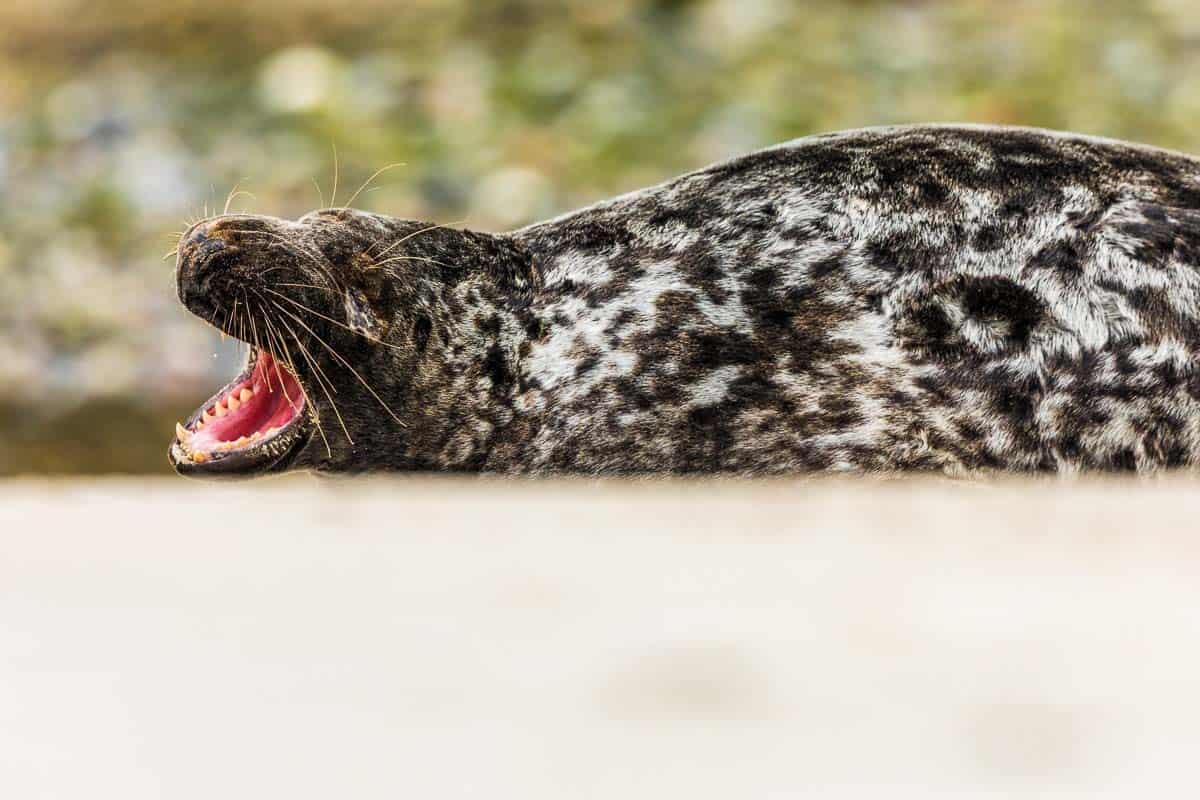
INTERESTING MARINE MAMMALS
CONCLUSION
Marine mammals are a vital addition to our oceans since they play important roles in helping maintain equilibrium within food-chains to ensure balanced environments for years to come. Fortunately, excessive hunting has drastically slowed down due to strict international rules that prohibit their hunt, allowing many populations of marine mammals to recover from excessive hunting.
Nevertheless, some species were not able to recover and are nowadays nearing extinction, which is an extremely sad thought. Most threats that these species are currently facing are human-induced. Major threats include the commercial fishery, industrialization as well as climate change(2,4).
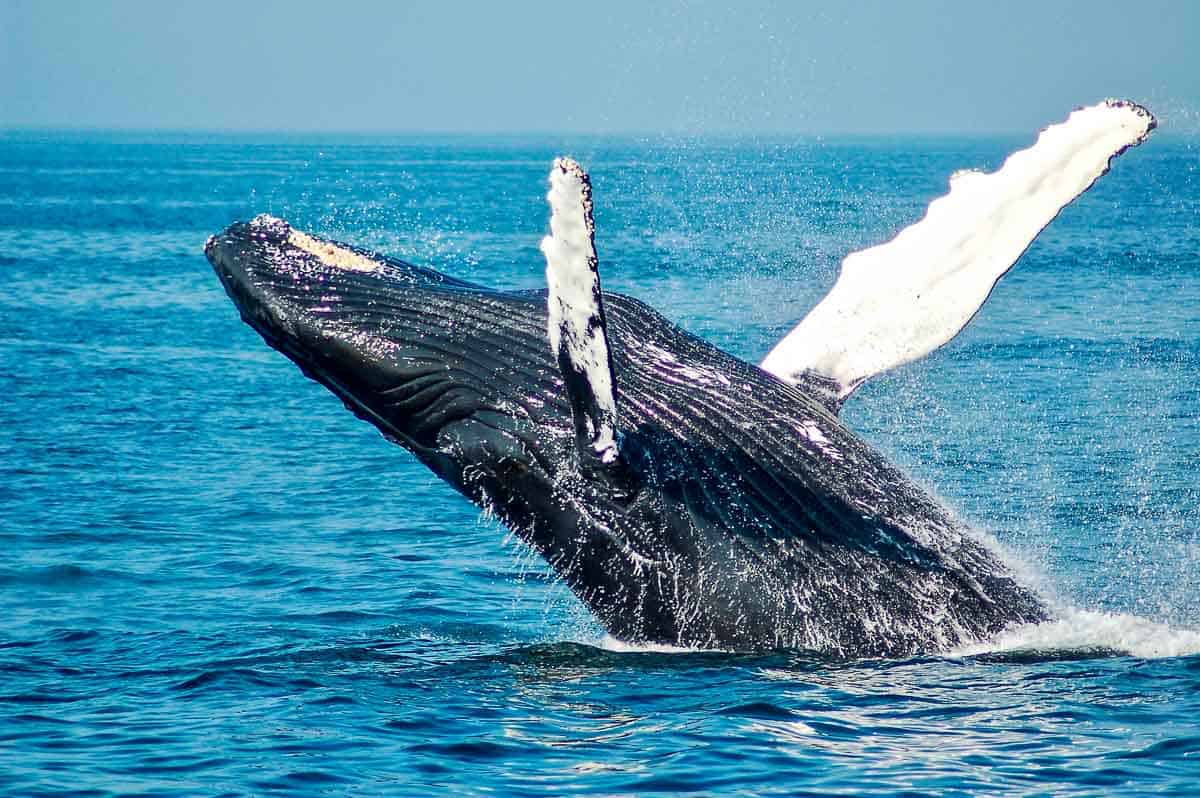
INTERESTING MARINE MAMMALS
FAQs
1. What mammals live in the ocean?
Marine mammals include all dolphins, porpoises, and whales, as well as manatees, dungeons, walruses, seals, and otters. While some marine mammals spend all their life in the ocean, others can go on land for extended periods of time. Marine mammals that make use of both the ocean and land as a habitat include – walruses, seals, and otters. These species typically use land to rest and raise their young, since rocky shores are safer from predators. However, these marine mammals still spend most of their time in the water, when foraging for food, or migrating to different locations.
2. What is the biggest creature in the ocean?
The biggest creature in the ocean is the Blue Whale. In fact, until this day, the Bue Whale is the biggest known creature that has ever lived on this planet. With a length of 82 ft (25m) and a weight of up to 330000 pounds (150000kg), these creatures can swim up to 31 mph (50km/h). Although the Blue Whale is the biggest creature on the planet, it is not well researched. Since it is so fast, it is difficult to conduct research and until this day we do not know where or how they breed. Nevertheless, after extensive whaling in the early 1900s and the following ban on international whale hunts, Blue Whale populations are only slowly recovering. Nowadays major threats include collisions with ships, food depletion due to extensive fishing, entanglement with fishing gear and habitat shifts through climate change.
3. What are the characteristics of marine mammals?
Marine mammals possess the same characteristics as all mammals, with the exception that they have adapted to living in the water. Characteristics of mammals include bearing live babies and nursing their young with milk that is produced by mammary glands. Mammals further are warm-blooded, breath air with their lungs and typically have fur or hair. Adaptations of marine mammals include streamlining body forms, the ability to store additional oxygen in muscles and blood, and a thick layer of fat against to insulate against cold.
4. How can marine mammals drink seawater?
It is not very well established that marine mammals drink seawater regularly. Some marine mammals have been observed to drink seawater occasionally, but not routinely. Instead, marine mammals get the majority of freshwater from the prey they are eating. This through internally extracting it during the metabolic breakdown while digesting prey. Here, water is counted as one of the by-products of breaking down carbohydrates and fat.
Marine mammals are very similar to terrestrial mammals and possess similar blood and body fluids that commonly contain about one-third of the salt content of ocean water. When drinking seawater, the body extracts the freshwater and releases the salt content back into the environment through urine. Measurements of urine in marine mammals only exist for seals and sea lions and researchers have found that their urine contains more than 2 times more salt than seawater.
5. How many types of dolphins are there?
Currently, a total of 49 different dolphin and porpoise species exist on the planet. The largest group are oceanic dolphins, which encompass 38 different species. There are a total of four different river dolphins and the remaining 7 species are porpoise species. An interesting fact about dolphins is that they live together in groups and are referred to as a pod of dolphins. The amounts of individuals in a pod of dolphins vary from species to species, but commonly consist of 2 to 30 individuals.
6. Why are dolphins important?
An interesting fact about dolphins is that they are notable indicators for the health of ecosystems. While feeding on different species of fish and squid, which contain contaminants absorbed from the environment, concentrations of these contaminants build-up within the bodies of dolphins, after consuming their prey. The concentration of contamination within dolphins can, therefore, serve as an indicator of the health of that ecosystem.
Pods of dolphins play a key role in keeping the environment in balance. While dolphins forage primarily on fish and squid, they are in turn a food source for larger predators, such as sharks. Nevertheless, an interesting fact about dolphins is that since they travel in pods, through teamwork, they are able to protect themselves from larger predators – even Great White Sharks.
There is a common belief that dolphins are benevolent animals, purposefully caring towards humans. There is truth to this: throughout history, there have been several stories of dolphins performing heroic acts to help humans. Dolphins have saved swimmers who had drifted out to sea and protected humans from sharks on numerous occasions. There are even Avenger-style dolphin celebrities like Pelorus Jack – the famous Risso’s dolphin of Cook Strait – who for over a decade would guide ships to safety. Mark Twain even ventured for a sighting of Old Jack. And this isn’t fresh news: the first recorded story of friendship between a man and a dolphin was told by Aristotle!
However, there are also several accounts, by both researchers and the public, of dolphins doing some rather perturbing stuff. Dolphins have been observed to attack people unprovoked (although this is incredibly rare). Keep in mind that Orcas are also dolphins (the largest of the species), and if I saw one of them underwater, I wouldn’t wait around to see if they would clap their fins or blow rings! Within their species, male dolphins have been observed ‘calf tossing’ – a form of infanticide. Similar to lions, they do this to rid their pods of calves that are not their own. Lastly, there are plenty of accounts of disturbing sexual behavior by male dolphins. Dolphins are one of the few species to have sex for pleasure. That is by no means alarming, but it is an important characteristic to consider when their behavior also includes incest, creative masturbation, aggressive group sex, and the occasional advance toward a human.
Both sets of stories, good and bad, essentially boil down to one thing: dolphins are hyper-intelligent and cannot be underestimated. Marine mammals are in many ways the shepherds of the ocean and dolphins are the most intelligent amongst them. In fact, many evolutionary biologists have a joke running that, had dolphins evolved to develop opposable thumbs, they could have become the dominant species on earth as opposed to us clumsy Homo sapiens. Until our genus overtook dolphins, they were likely the planet’s most intelligent species.
Marine mammals are a certain blessing – they deserve our fiercest protection and most devout conservation. Should you ever be blessed enough to swim amongst these wonders, interact with humility and the utmost respect!

INTERESTING MARINE MAMMALS
SOURCES
- nationalgeographic.com, nationalgeographic.com
- iucnredlist.org, iucnredlist.org
- wwf.panda.org, wwf.panda.org
- sciencedirect.com, sciencedirect.com
REACH OUT
More on the ocean and sustainability, check out our articles on sea turtles, the great pacific garbage patch, environment sustainability and plastic recycling. As always, we create our content with you, fellow divers, in mind. So, how’d we do? Did you find this informative? Did it help you make a decision? Did we miss anything? We’d love to hear from you below. Thanks for reading and we hope your next dive is a great one!

